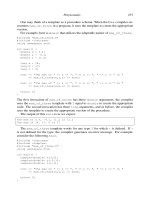Java Concepts 5th Edition and 6th phần 6 doc
Bạn đang xem bản rút gọn của tài liệu. Xem và tải ngay bản đầy đủ của tài liệu tại đây (969.78 KB, 111 trang )
Java Concepts, 5th Edition
Output
Average area: 625
Expected: 625
Maximum area rectangle:
java.awt.Rectangle[x=10,y=20,width=30,height=40]
Expected:
java.awt.Rectangle[x=10,y=20,width=30,height=40]
SELF CHECK
8. Suppose you want to use the DataSet class of Section 9.1 to find the
longest String from a set of inputs. Why can't this work?
9. How can you use the DataSet class of this section to find the longest
String from a set of inputs?
10. Why does the measure method of the Measurer interface have one
more parameter than the getMeasure method of the Measurable
interface?
9.5 Inner Classes
The RectangleMeasurer class is a very trivial class. We need this class only
because the DataSet class needs an object of some class that implements the
Measurer interface. When you have a class that serves a very limited purpose, such
as this one, you can declare the class inside the method that needs it:
public class DataSetTester3
{
public static void main(String[] args)
{
class RectangleMeasurer implements Measurer
{
. . .
}
Measurer m = new RectangleMeasurer();
DataSet data = new DataSet(m);
. . .
}
}
402
403
Chapter 9 Interfaces and Polymorphism Page 21 of 68
Java Concepts, 5th Edition
Such a class is called an inner class. An inner class is any class that is defined inside
another class. This arrangement signals to the reader of your program that the
RectangleMeasurer class is not interesting beyond the scope of this method.
Since an inner class inside a method is not a publicly accessible feature, you don't
need to document it as thoroughly.
An inner class is declared inside another class. Inner classes are commonly used
for tactical classes that should not be visible elsewhere in a program.
You can also define an inner class inside an enclosing class, but outside of its
methods. Then the inner class is available to all methods of the enclosing class.
SYNTAX 9.3: Inner Classes
Declared inside a method:
class OuterClassName
{
method signature
{
. . .
class InnerClassName
{
methods
fields
}
. . .
}
. . .
}
Declared inside the class:
class OuterClassName
{
methods
fields
accessSpecifier class
InnerClassName
{
methods
fields
}
. . .
}
Example
public class Tester
{
public static void main(String[] args)
{
class RectangleMeasurer implements Measurer
{
. . .
}
. . .
}
}
403
404
Chapter 9 Interfaces and Polymorphism Page 22 of 68
Java Concepts, 5th Edition
Purpose
To define an inner class whose scope is restricted to a single method or the
methods of a single class
When you compile the source files for a program that uses inner classes, have a look
at the class files in your program directory—you will find that the inner classes are
stored in files with curious names, such as
DataSetTester3$1$RectangleMeasurer.class. The exact names aren't
important. The point is that the compiler turns an inner class into a regular class file.
ch09/measure3/DataSetTester3.java
1 import java.awt.Rectangle;
2
3 /**
4 This program demonstrates the use of an inner class.
5 */
6 public class DataSetTester3
7 {
8 public static void main(String[] args)
9 {
10 class RectangleMeasurer implements
Measurer
11 {
12 public double measure(Object anObject)
13 {
14 Rectangle aRectangle = (Rectangle)
anObject;
15 double area
16 = aRectangle.getWidth() *
aRectangle.getHeight();
17 return area;
18 }
19 }
20
21 Measurer m = new RectangleMeasurer();
22
23 DataSet data = new DataSet(m);
24
25 data.add(new Rectangle(5, 10, 20, 30));
26 data.add(new Rectangle(10, 20, 30, 40));
404
405
Chapter 9 Interfaces and Polymorphism Page 23 of 68
Java Concepts, 5th Edition
27 data.add(new Rectangle(20, 30, 5, 15));
28
29 System.out.println("Average area: " +
data.getAverage());
30 System.out.println("Expected: 625");
31
32 Rectangle max = (Rectangle)
data.getMaximum();
33 System.out.println("Maximum area
rectangle: " + max);
34 System.out.println("Expected:
java.awt.Rectangle[
35 x=10,y=20,width=30,height=40]");
36 }
37 }
SELF CHECK
11. Why would you use an inner class instead of a regular class?
12. How many class files are produced when you compile the
DataSetTester3 program?
ADVANCED TOPIC 9.2: Anonymous Classes
An entity is anonymous if it does not have a name. In a program, something that is
only used once doesn't usually need a name. For example, you can replace
Coin aCoin = new Coin(0.1, "dime");
data.add(aCoin);
with
data.add(new Coin(0.1, "dime"));
if the coin is not used elsewhere in the same method. The object new
Coin(0.1, "dime") is an anonymous object. Programmers like anonymous
objects, because they don't have to go through the trouble of coming up with a
name. If you have struggled with the decision whether to call a coin c, dime, or
aCoin, you'll understand this sentiment.
405
Chapter 9 Interfaces and Polymorphism Page 24 of 68
Java Concepts, 5th Edition
Inner classes often give rise to a similar situation. After a single object of the
Rectangle-Measurer has been constructed, the class is never used again. In
Java, it is possible to define anonymous classes if all you ever need is a single
object of the class.
public static void main(String[] args)
{
// Construct an object of an anonymous class
Measurer m = new Measurer()
// Class definition starts here
{
public double measure(Object anObject)
{
Rectangle aRectangle = (Rectangle)
anObject;
double area = aRectangle.getWidth() *
aRectangle.getHeight();
return area;
}
};
DataSet data = new DataSet(m);
. . .
}
This means: Construct an object of a class that implements the Measurer
interface by defining the measure method as specified. Many programmers like
this style, but we will not use it in this book.
RANDOM FACT 9.1: Operating Systems
Without an operating system, a computer would not be useful. Minimally, you
need an operating system to locate files and to start programs. The programs that
you run need services from the operating system to access devices and to interact
with other programs. Operating systems on large computers need to provide more
services than those on personal computers do.
Here are some typical services:
• Program loading. Every operating system provides some way of launching
application programs. The user indicates what program should be run,
405
406
Chapter 9 Interfaces and Polymorphism Page 25 of 68
Java Concepts, 5th Edition
usually by typing the name of the program or by clicking on an icon. The
operating system locates the program code, loads it into memory, and starts
it.
• Managing files. A storage device, such as a hard disk is, electronically,
simply a device capable of storing a huge sequence of zeroes and ones. It is
up to the operating system to bring some structure to the storage layout and
organize it into files, folders, and so on. The operating system also needs to
impose some amount of security and redundancy into the file system so that
a power outage does not jeopardize the contents of an entire hard disk. Some
operating systems do a better job in this regard than others.
• Virtual memory. RAM is expensive, and few computers have enough RAM
to hold all programs and their data that a user would like to run
simultaneously. Most operating systems extend the available memory by
storing some data on the hard disk. The application programs do not realize
whether a particular data item is in memory or in the virtual memory disk
storage. When a program accesses a data item that is currently not in RAM,
the processor senses this and notifies the operating system. The operating
system swaps the needed data from the hard disk into RAM, simultaneously
swapping out a memory block of equal size that had not been accessed for
some time.
• Handling multiple users. The operating systems of large and powerful
computers allow simultaneous access by multiple users. Each user is
connected to the computer through a separate terminal. The operating
system authenticates users by checking that each one has a valid account and
password. It gives each user a small slice of processor time, then serves the
next user.
• Multitasking. Even if you are the sole user of a computer, you may want to
run multiple applications—for example, to read your e-mail in one window
and run the Java compiler in another. The operating system is responsible
for dividing processor time between the applications you are running, so that
each can make progress.
406
Chapter 9 Interfaces and Polymorphism Page 26 of 68
Java Concepts, 5th Edition
A Graphical Software Environment for the Linux Operating System
• Printing. The operating system queues up the print requests that are sent by
multiple applications. This is necessary to make sure that the printed pages
do not contain a mixture of words sent simultaneously from separate
programs.
• Windows. Many operating systems present their users with a desktop made
up of multiple windows. The operating system manages the location and
appearance of the window frames; the applications are responsible for the
interiors.
• Fonts. To render text on the screen and the printer, the shapes of characters
must be defined. This is especially important for programs that can display
multiple type styles and sizes. Modern operating systems contain a central
font repository.
• Communicating between programs. The operating system can facilitate the
transfer of information between programs. That transfer can happen through
406
407
Chapter 9 Interfaces and Polymorphism Page 27 of 68
Java Concepts, 5th Edition
cut and paste or interprocess communication. Cut and paste is a
user-initiated data transfer in which the user copies data from one
application into a transfer buffer (often called a “clipboard”) managed by the
operating system and inserts the buffer's contents into another application.
Interprocess communication is initiated by applications that transfer data
without direct user involvement.
• Networking. The operating system provides protocols and services for
enabling applications to reach information on other computers attached to
the network.
Today, the most popular operating systems for personal computers are Linux (see
figure), the Macintosh OS, and Microsoft Windows.
9.6 Events, Event Sources, and Event Listeners
In the applications that you have written so far, user input was under control of the
program. The program asked the user for input in a specific order. For example, a
program might ask the user to supply first a name, then a dollar amount. But the
programs that you use every day on your computer don't work like that. In a program
with a modern graphical user interface, the user is in control. The user can use both
the mouse and the keyboard and can manipulate many parts of the user interface in
any desired order. For example, the user can enter information into text fields, pull
down menus, click buttons, and drag scroll bars in any order. The program must react
to the user commands, in whatever order they arrive. Having to deal with many
possible inputs in random order is quite a bit harder than simply forcing the user to
supply input in a fixed order.
In the following sections, you will learn how to write Java programs that can react to
user interface events, such as button pushes and mouse clicks. The Java windowing
toolkit has a very sophisticated mechanism that allows a program to specify the
events in which it is interested and which objects to notify when one of these events
occurs.
User interface events include key presses, mouse moves, button clicks, menu
selections, and so on.
407
408
Chapter 9 Interfaces and Polymorphism Page 28 of 68
Java Concepts, 5th Edition
Whenever the user of a graphical program types characters or uses the mouse
anywhere inside one of the windows of the program, the Java window manager sends
a notification to the program that an event has occurred. The window manager
generates huge numbers of events. For example, whenever the mouse moves a tiny
interval over a window, a “mouse move” event is generated. Events are also
generated when the user presses a key, clicks a button, or selects a menu item.
Most programs don't want to be flooded by boring events. For example, when a
button is clicked with the mouse, the mouse moves over the button, then the mouse
button is pressed, and finally the button is released. Rather than receiving lots of
irrelevant mouse events, a program can indicate that it only cares about button clicks,
not about the underlying mouse events. However, if the mouse input is used for
drawing shapes on a virtual canvas, it is necessary to closely track mouse events.
An event listener belongs to a class that is provided by the application
programmer. Its methods describe the actions to be taken when an event occurs.
Every program must indicate which events it needs to receive. It does that by
installing event listener objects. An event listener object belongs to a class that you
define. The methods of your event listener classes contain the instructions that you
want to have executed when the events occur.
To install a listener, you need to know the event source. The event source is the user
interface component that generates a particular event. You add an event listener
object to the appropriate event sources. Whenever the event occurs, the event source
calls the appropriate methods of all attached event listeners.
Event sources report on events. When an event occurs, the event source notifies all
event listeners.
Use JButton components for buttons. Attach an ActionListener to each
button.
408
409
Chapter 9 Interfaces and Polymorphism Page 29 of 68
Java Concepts, 5th Edition
This sounds somewhat abstract, so let's run through an extremely simple program that
prints a message whenever a button is clicked. Button listeners must belong to a class
that implements the ActionListener interface:
public interface ActionListener
{
void actionPerformed(ActionEvent event);
}
This particular interface has a single method, actionPerformed. It is your job to
supply a class whose actionPerformed method contains the instructions that you
want executed whenever the button is clicked. Here is a very simple example of such
a listener class:
ch09/button1/ClickListener.java
1 import java.awt.event.ActionEvent;
2 import java.awt.event.ActionListener;
3
4 /**
5 An action listener that prints a message.
6 */
7 public class ClickListener implements
ActionListener
8 {
9 public void actionPerformed(ActionEvent
event)
10 {
11 System.out.println("I was clicked.");
12 }
13 }
We ignore the event parameter of the actionPerformed method—it contains
additional details about the event, such as the time at which it occurred.
Once the listener class has been defined, we need to construct an object of the class
and add it to the button:
ActionListener listener = new ClickListener();
button.addActionListener(listener);
Whenever the button is clicked, it calls
Chapter 9 Interfaces and Polymorphism Page 30 of 68
Java Concepts, 5th Edition
listener.actionPerformed(event);
As a result, the message is printed.
You can think of the actionPerformed method as another example of a callback,
similar to the measure method of the Measurer class. The windowing toolkit calls
the actionPerformed method whenever the button is pressed, whereas the
DataSet calls the measure method whenever it needs to measure an object.
You can test this program out by opening a console window, starting the
ButtonViewer program from that console window, clicking the button, and
watching the messages in the console window (see Figure 3).
Figure 3
Implementing an Action Listener
ch09/button1/ButtonViewer.java
1 import java.awt.event.ActionListener;
2 import javax.swing.JButton;
3 import javax.swing.JFrame;
4
5 /**
6 This program demonstrates how to install an action listener.
7 */
8 public class ButtonViewer
9 {
10 public static void main(String[] args)
409
410
Chapter 9 Interfaces and Polymorphism Page 31 of 68
Java Concepts, 5th Edition
11 {
12 JFrame frame = new JFrame();
13 JButton button = new JButton(”Click me!”);
14 frame.add(button);
15
16 ActionListener listener = new
ClickListener();
17 button.addActionListener(listener);
18
19 frame.setSize(FRAME_WIDTH, FRAME_HEIGHT);
20 frame.setDefaultCloseOperation(JFrame.EXIT_ON_
CLOSE
21 frame.setVisible(true);
22 }
23
24 private static final int FRAME_WIDTH = 100;
25 private static final int FRAME_HEIGHT = 60;
26 }
SELF CHECK
13. Which objects are the event source and the event listener in the
ButtonViewer program?
14. Why is it legal to assign a ClickListener object to a variable of
type ActionListener?
COMMON ERROR 9.3: Modifying the Signature in the
Implementing Method
When you implement an interface, you must define each method exactly as it is
specified in the interface. Accidentally making small changes to the parameter or
return types is a COMMON ERROR. Here is the classic example,
class MyListener implements ActionListener
{
public void actionPerformed()
// Oops . . . forgot ActionEvent parameter
{
. . .
}
}
410
411
Chapter 9 Interfaces and Polymorphism Page 32 of 68
Java Concepts, 5th Edition
As far as the compiler is concerned, this class has two methods:
public void actionPerformed(ActionEvent event)
public void actionPerformed()
The first method is undefined. The compiler will complain that the method is
missing. You have to read the error message carefully and pay attention to the
parameter and return types to find your error.
9.7 Using Inner Classes for Listeners
In the preceding section, you saw how the code that is executed when a button is
clicked is placed into a listener class. It is common to implement listener classes as
inner classes like this:
JButton button = new JButton(". . .");
// This inner class is declared in the same method as the button variable
class MyListener implements ActionListener
{
. . .
};
ActionListener listener = new MyListener();
button.addActionListener(listener);
There are two reasons for this arrangement. First, it places the trivial listener class
exactly where it is needed, without cluttering up the remainder of the project.
Moreover, inner classes have a very attractive feature: Their methods can access
variables that are defined in surrounding blocks. In this regard, method definitions of
inner classes behave similarly to nested blocks.
Recall that a block is a statement group enclosed by braces. If a block is nested inside
another, the inner block has access to all variables from the surrounding block:
{ // Surrounding block
BankAccount account = new BankAccount();
if (. . .)
{ // Inner block
. . .
// OK to access variable from surrounding block
411
412
Chapter 9 Interfaces and Polymorphism Page 33 of 68
Java Concepts, 5th Edition
account.deposit(interest);
. . .
} // End of inner block
. . .
} // End of surrounding block
The same nesting works for inner classes. Except for some technical restrictions,
which we will examine later in this section, the methods of an inner class can access
the variables from the enclosing scope. This feature is very useful when
implementing event handlers. It allows the inner class to access variables without
having to pass them as constructor or method parameters.
Methods of an inner class can access local variables from surrounding blocks and
fields from surrounding classes.
Let's look at an example. Suppose we want to add interest to a bank account
whenever a button is clicked.
JButton button = new JButton("Add Interest");
final BankAccount account = new
BankAccount(INITIAL_BALANCE);
// This inner class is declared in the same method as the account and button
variables.
class AddInterestListener implements ActionListener
{
public void actionPerformed(ActionEvent event)
{
// The listener method accesses the account variable
// from the surrounding block
double interest = account.getBalance()
* INTEREST_RATE / 100;
account.deposit(interest);
}
};
ActionListener listener = new AddInterestListener();
button.addActionListener(listener);
There is a technical wrinkle. An inner class can access surrounding local variables
only if they are declared as final. That sounds like a restriction, but it is usually not
Chapter 9 Interfaces and Polymorphism Page 34 of 68
Java Concepts, 5th Edition
an issue in practice. Keep in mind that an object variable is final when the variable
always refers to the same object. The state of the object can change, but the variable
can't refer to a different object. For example, in our program, we never intended to
have the account variable refer to multiple bank accounts, so there was no harm in
declaring it as final.
Local variables that are accessed by an inner-class method must be declared as
final.
An inner class can also access fields of the surrounding class, again with a restriction.
The field must belong to the object that constructed the inner class object. If the inner
class object was created inside a static method, it can only access static surrounding
fields.
Here is the source code for the program.
ch09/button2/InvestmentViewer1.java
1 import java.awt.event.ActionEvent;
2 import java.awt.event.ActionListener;
3 import javax.swing.JButton;
4 import javax.swing.JFrame;
5
6 /**
7 This program demonstrates how an action listener can access
8 a variable from a surrounding block.
9 */
10 public class InvestmentViewer1
11 {
12 public static void main(String[] args)
13 {
14 JFrame frame = new JFrame();
15
16 // The button to trigger the calculation
17 JButton button = new JButton("Add
Interest");
18 frame.add(button);
19
20 // The application adds interest to this bank account
412
413
Chapter 9 Interfaces and Polymorphism Page 35 of 68
Java Concepts, 5th Edition
21 final BankAccount account = new
BankAccount(INITIAL_BALANCE);
22
23 class AddInterestListener implements
ActionListener
24 {
25 public void
actionPerformed(ActionEvent event)
26 {
27 // The listener method accesses the account variable
28 // from the surrounding block
29 double interest =
account.getBalance()
30 * INTEREST_RATE / 100;
31 account.deposit(interest);
32 System.out.println("balance: " +
account.getBalance());
33 }
34 }
35
36 ActionListener listener = new
AddInterestListener();
37 button.addActionListener(listener);
38
39 frame.setSize(FRAME_WIDTH, FRAME_HEIGHT);
40 frame.setDefaultCloseOperation(JFrame.EXIT_ON_
CLOSE
41 frame.setVisible(true);
42 }
43
44 private static final double INTEREST_RATE =
10;
45 private static final double INITIAL_BALANCE
= 1000;
46
47 private static final int FRAME_WIDTH = 120;
48 private static final int FRAME_HEIGHT = 60;
49 }
Output
balance: 1100.0
balance: 1210.0
balance: 1331.0
balance: 1464.1
413
414
Chapter 9 Interfaces and Polymorphism Page 36 of 68
Java Concepts, 5th Edition
SELF CHECK
15. Why would an inner class method want to access a variable from a
surrounding scope?
16. If an inner class accesses a local variable from a surrounding scope,
what special rule applies?
9.8 Building Applications with Buttons
In this section, you will learn how to structure a graphical application that contains
buttons. We will put a button to work in our simple investment viewer program.
Whenever the button is clicked, interest is added to a bank account, and the new
balance is displayed (see Figure 4).
First, we construct an object of the JButton class. Pass the button label to the
constructor:
JButton button = new JButton("Add Interest");
We also need a user interface component that displays a message, namely the current
bank balance. Such a component is called a label. You pass the initial message string
to the JLabel constructor, like this:
JLabel label = new JLabel("balance: " +
account.getBalance());
Figure 4
An Application with a Button
The frame of our application contains both the button and the label. However, we
cannot simply add both components directly to the frame—they would be placed on
414
415
Chapter 9 Interfaces and Polymorphism Page 37 of 68
Java Concepts, 5th Edition
top of each other. The solution is to put them into a panel, a container for other
user-interface components, and then add the panel to the frame:
JPanel panel = new JPanel();
panel.add(button);
panel.add(label);
frame.add(panel);
Use a JPanel container to group multiple user-interface components together.
Now we are ready for the hard part—the event listener that handles button clicks. As
in the preceding section, it is necessary to define a class that implements the
ActionListener interface, and to place the button action into the
actionPerformed method. Our listener class adds interest and displays the new
balance:
class AddInterestListener implements ActionListener
{
public void actionPerformed(ActionEvent event)
{
double interest = account.getBalance() *
INTEREST_RATE / 100;
account.deposit(interest);
label.setText("balance: " +
account.getBalance());
}
}
There is just a minor technicality. The actionPerformed method manipulates the
account and label variables. These are local variables of the main method of the
investment viewer program, not instance fields of the AddInterestListener
class. We therefore need to declare the account and label variables as final so
that the actionPerformed method can access them.
You often install event listeners as inner classes so that they can have access to the
surrounding fields, methods, and final variables.
Let's put the pieces together.
public static void main(String[] args)
{
Chapter 9 Interfaces and Polymorphism Page 38 of 68
Java Concepts, 5th Edition
. . .
JButton button = new JButton("Add Interest");
final BankAccount account = new
BankAccount(INITIAL_BALANCE);
final JLabel label = new JLabel("balance: " +
account.getBalance());
class AddInterestListener implements
ActionListener
{
public void actionPerformed(ActionEvent event)
{
double interest = account.getBalance()
* INTEREST_RATE / 100;
account.deposit(interest);
label.setText("balance: " +
account.getBalance());
}
}
ActionListener listener = new
AddInterestListener();
button.addActionListener(listener);
. . .
}
With a bit of practice, you will learn to glance at this code and translate it into plain
English: “When the button is clicked, add interest and set the label text.”
Here is the complete program. It demonstrates how to add multiple components to a
frame, by using a panel, and how to implement listeners as inner classes.
ch09/button3/InvestmentViewer2.java
1 import java.awt.event.ActionEvent;
2 import java.awt.event.ActionListener;
3 import javax.swing.JButton;
4 import javax.swing.JFrame;
5 import javax.swing.JLabel;
6 import javax.swing.JPanel;
7 import javax.swing.JTextField;
8
9 /**
10 This program displays the growth of an investment.
11 */
12 public class InvestmentViewer2
415
416
Chapter 9 Interfaces and Polymorphism Page 39 of 68
Java Concepts, 5th Edition
13 {
14 public static void main(String[] args)
15 {
16 JFrame frame = new JFrame();
17
18 // The button to trigger the calculation
19 JButton button = new JButton("Add
Interest");
20
21 // The application adds interest to this bank account
22 final BankAccount account = new
BankAccount(INITIAL_BALANCE);
23
24 // The label for displaying the results
25 final JLabel label = new JLabel(
26 "balance: " +
account.getBalance());
27
28 // The panel that holds the user interface components
29 JPanel panel = new JPanel();
30 panel.add(button);
31 panel.add(label);
32 frame.add(panel);
33
34 class AddInterestListener implements
ActionListener
35 {
36 public void
actionPerformed(ActionEvent event)
37 {
38 double interest =
account.getBalance()
39 * INTEREST_RATE / 100;
40 account.deposit(interest);
41 label.setText(
42 "balance: " +
account.getBalance());
43 }
44 }
45
46 ActionListener listener = new
AddInterestListener();
47 button.addActionListener(listener);
48
416
417
Chapter 9 Interfaces and Polymorphism Page 40 of 68
Java Concepts, 5th Edition
49 frame.setSize(FRAME_WIDTH, FRAME_HEIGHT);
50 frame.setDefaultCloseOperation(JFrame.EXIT_ON_
CLOSE
51 frame.setVisible(true);
52 }
53
54 private static final double INTEREST_RATE =
10;
55 private static final double INITIAL_BALANCE
= 1000;
56
57 private static final int FRAME_WIDTH = 400;
58 private static final int FRAME_HEIGHT = 100;
59 }
SELF CHECK
17. How do you place the “balance: . . .” message to the left of the
"Add Interest" button?
18. Why was it not necessary to declare the button variable as final?
COMMON ERROR 9.4: Forgetting to Attach a Listener
If you run your program and find that your buttons seem to be dead, double-check
that you attached the button listener. The same holds for other user interface
components. It is a surprisingly COMMON ERROR to program the listener class and
the event handler action without actually attaching the listener to the event source.
PRODUCTIVITY HINT 9.1: Don't Use a Container as a
Listener
In this book, we use inner classes for event listeners. That approach works for
many different event types. Once you master the technique, you don't have to think
about it anymore. Many development environments automatically generate code
with inner classes, so it is a good idea to be familiar with them.
However, some programmers bypass the event listener classes and instead turn a
container (such as a panel or frame) into a listener. Here is a typical example. The
Chapter 9 Interfaces and Polymorphism Page 41 of 68
Java Concepts, 5th Edition
actionPerformed method is added to the viewer class. That is, the viewer
implements the ActionListener interface.
public class InvestmentViewer
implements ActionListener// This approach is not
recommended
{
public InvestmentViewer()
{
JButton button = new JButton("Add Interest");
button.addActionListener(this);
. . .
}
public void actionPerformed(ActionEvent event)
{
}
. . .
}
Now the actionPerformed method is a part of the InvestmentViewer
class rather than part of a separate listener class. The listener is installed as this.
This technique has two major flaws. First, it separates the button definition from
the button action. Also, it doesn't scale well. If the viewer class contains two
buttons that each generate action events, then the actionPerformed method
must investigate the event source, which leads to code that is tedious and
error-prone.
9.9 Processing Timer Events
In this section we will study timer events and show how they allow you to implement
simple animations.
The Timer class in the javax.swing package generates a sequence of action
events, spaced apart at even time intervals. (You can think of a timer as an invisible
button that is automatically clicked.) This is useful whenever you want to have an
object updated in regular intervals. For example, in an animation, you may want to
update a scene ten times per second and redisplay the image, to give the illusion of
movement.
417
418
Chapter 9 Interfaces and Polymorphism Page 42 of 68
Java Concepts, 5th Edition
A timer generates timer events at fixed intervals.
When you use a timer, you specify the frequency of the events and an object of a
class that implements the ActionListener interface. Place whatever action you
want to occur inside the actionPerformed method. Finally, start the timer.
class MyListener implements ActionListener
{
public void actionPerformed(ActionEvent event)
{
// This action will be executed at each timer event
Place listener action here
}
}
MyListener listener = new MyListener();
Timer t = new Timer (interval, listener);
t.start();
Then the timer calls the actionPerformed method of the listener object
every interval milliseconds.
Our sample program will display a moving rectangle. We first supply a
RectangleComponent class with a moveBy method that moves the rectangle by
a given amount.
ch09/timer/RectangleComponent.java
1 import java.awt.Graphics;
2 import java.awt.Graphics2D;
3 import java.awt.Rectangle;
4 import javax.swing.JComponent;
5
6 /**
7 This component displays a rectangle that can be moved.
8 */
9 public class RectangleComponent extends
JComponent
10 {
11 public RectangleComponent()
12 {
13 // The rectangle that the paint method draws
418
419
Chapter 9 Interfaces and Polymorphism Page 43 of 68
Java Concepts, 5th Edition
14 box = new Rectangle(BOX_X, BOX_Y,
15 BOX_WIDTH, BOX_HEIGHT);
16 }
17
18 public void paintComponent(Graphics g)
19 {
20 super.paintComponent(g);
21 Graphics2D g2 = (Graphics2D) g;
22
23 g2.draw(box);
24 }
25
26 /**
27 Moves the rectangle by a given amount.
28 @param x the amount to move in the x-direction
29 @param y the amount to move in the y-direction
30 */
31 public void moveBy(int dx, int dy)
32 {
33 box.translate(dx, dy);
34 repaint();
35 }
36
37 private Rectangle box;
38
39 private static final int BOX_X = 100;
40 private static final int BOX_Y = 100;
41 private static final int BOX_WIDTH = 20;
42 private static final int BOX_HEIGHT = 30;
43 }
Note the call to repaint in the moveBy method. This call is necessary to ensure
that the component is repainted after the state of the rectangle object has been
changed. Keep in mind that the component object does not contain the pixels that
show the drawing. The component merely contains a Rectangle object, which
itself contains four coordinate values. Calling translate updates the rectangle
coordinate values. The call to repaint forces a call to the paintComponent
method. The paintComponent method redraws the component, causing the
rectangle to appear at the updated location.
419
420
Chapter 9 Interfaces and Polymorphism Page 44 of 68
Java Concepts, 5th Edition
The repaint method causes a component to repaint itself. Call this method
whenever you modify the shapes that the paintComponent method draws.
The actionPerformed method of the timer listener simply calls
component.moveBy(1, 1). This moves the rectangle one pixel down and to the
right. Since the actionPerformed method is called many times per second, the
rectangle appears to move smoothly across the frame.
ch09/timer/RectangleMover.java
1 import java.awt.event.ActionEvent;
2 import java.awt.event.ActionListener;
3 import javax.swing.JFrame;
4 import javax.swing.Timer;
5
6 /**
7 This program moves the rectangle.
8 */
9 public class RectangleMover
10 {
11 public static void main(String[] args)
12 {
13 JFrame frame = new JFrame();
14
15 frame.setSize(FRAME_WIDTH, FRAME_HEIGHT);
16 frame.setTitle("An animated rectangle");
17 frame.setDefaultCloseOperation(JFrame.EXIT_ON_
CLOSE
18
19 final RectangleComponent component = new
RectangleComponent();
20 frame.add(component);
21
22 frame.setVisible(true);
23
24 class TimerListener implements
ActionListener
25 {
26 public void
actionPerformed(ActionEvent event)
27 {
28 component.moveBy(1, 1);
Chapter 9 Interfaces and Polymorphism Page 45 of 68









